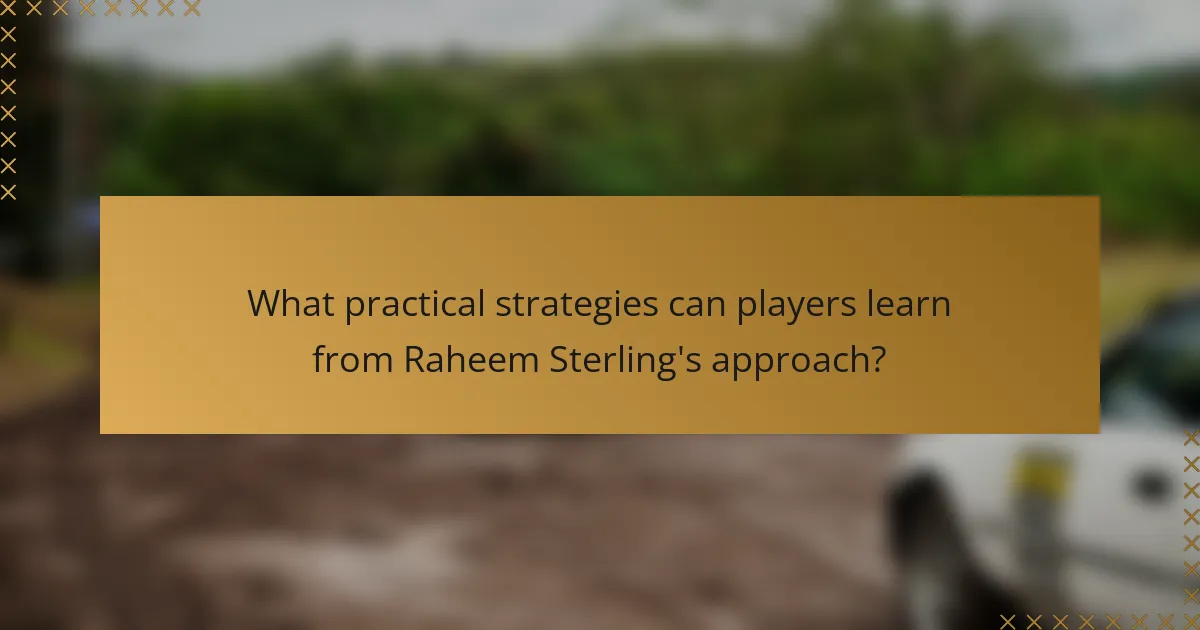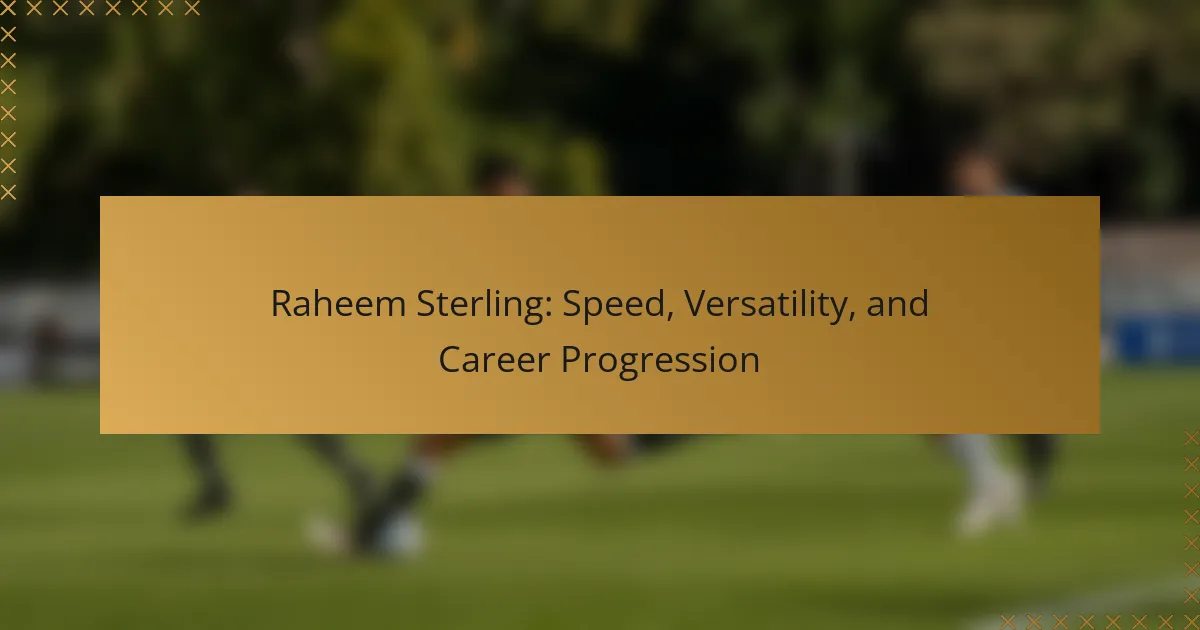Raheem Sterling’s exceptional speed and versatility make him a standout player in football. This article explores his remarkable acceleration and agility, tactical flexibility across attacking positions, and significant career progression through key stages at clubs like Liverpool and Manchester City. Additionally, we will examine his evolving playing style and the practical strategies that can be learned from his approach to the game.

What are the key attributes of Raheem Sterling’s speed?
Raheem Sterling’s speed is characterized by remarkable acceleration, quick footwork, and agility. His ability to reach top speeds rapidly allows him to outpace defenders effectively. Sterling’s unique trait is his explosive first step, which contributes significantly to his versatility in various attacking positions. Additionally, his speed enables him to exploit defensive gaps, creating scoring opportunities for himself and teammates.
How does Raheem Sterling’s speed compare to other players?
Raheem Sterling’s speed is among the fastest in football, often compared favourably to top players. His acceleration and top speed reach approximately 35 km/h, making him a key asset in counter-attacks. Compared to players like Kylian Mbappé and Adama Traoré, Sterling showcases remarkable agility and quickness in tight spaces, enhancing his versatility on the pitch.
What impact does speed have on Sterling’s playing style?
Speed significantly enhances Raheem Sterling’s playing style by enabling quick transitions and effective dribbling. His acceleration allows him to exploit defensive gaps, creating scoring opportunities. This agility contributes to his versatility, allowing him to adapt to various attacking roles. Sterling’s speed also pressures opponents, forcing defensive errors and opening space for teammates.

How does Raheem Sterling demonstrate versatility on the field?
Raheem Sterling demonstrates versatility on the field through his ability to play multiple attacking positions effectively. His speed allows him to exploit defenses, while his technical skills enable him to adapt to various game situations. Sterling’s experience in both wing and central roles showcases his unique attribute of tactical flexibility, making him a valuable asset to any team. Additionally, his consistent performance across different leagues highlights his adaptability to diverse playing styles and strategies.
Which positions can Raheem Sterling effectively play?
Raheem Sterling can effectively play as a winger, forward, or attacking midfielder. His speed and versatility allow him to adapt to various attacking roles. Primarily, he excels on the left wing, utilizing his dribbling skills and pace to create scoring opportunities. Additionally, he can operate as a central forward, showcasing his goal-scoring ability. His adaptability is a unique attribute that enhances his value to any team.
What are the advantages of Sterling’s versatility for his teams?
Raheem Sterling’s versatility provides significant advantages for his teams, enhancing tactical flexibility and offensive options. His ability to play multiple positions allows coaches to adapt strategies based on opponents. Sterling’s speed contributes to quick counterattacks, creating scoring opportunities. Additionally, his experience in high-pressure situations fosters team confidence and resilience. These attributes make him a valuable asset in various match scenarios.

What has been the trajectory of Raheem Sterling’s career progression?
Raheem Sterling’s career has progressed through key stages, showcasing his speed and versatility. He began at QPR, moved to Liverpool, and gained prominence. At Liverpool, he won the PFA Young Player of the Year award in 2014. His transfer to Manchester City in 2015 marked a significant turning point, where he achieved multiple Premier League titles and personal accolades. In 2022, he joined Chelsea, continuing to demonstrate his impact in the Premier League. Throughout his career, Sterling has been known for his exceptional dribbling and goal-scoring ability, making him a valuable asset to every team he has played for.
How did Sterling’s early career shape his development as a player?
Raheem Sterling’s early career at Liverpool laid the foundation for his development as a versatile player. His speed and agility allowed him to excel in various attacking positions. At Liverpool, he gained invaluable experience under pressure, enhancing his decision-making skills. This environment fostered his adaptability, enabling him to thrive in different roles at Manchester City and the national team. Sterling’s early exposure to top-level competition significantly shaped his growth and success as a professional footballer.
What milestones have defined Sterling’s career in recent years?
Raheem Sterling’s career has been defined by significant milestones such as his transfer to Manchester City in 2015, winning multiple Premier League titles, and his standout performances in international tournaments. His speed and versatility have made him a key player in various attacking roles. In recent years, his move to Chelsea in 2022 marked a new chapter, showcasing his adaptability in a different team environment. Additionally, his contributions to England’s national team during UEFA Euro 2020 highlighted his growth as a leader and crucial player on the international stage.

Which unique skills set Raheem Sterling apart from other players?
Raheem Sterling stands out due to his exceptional speed, tactical versatility, and consistent career progression. His pace allows him to outmaneuver defenders, while his adaptability enables him to excel in various attacking roles. Sterling’s ability to improve continuously and perform under pressure distinguishes him from peers. His unique combination of attributes contributes to his effectiveness on the pitch and enhances his overall impact in matches.
How does Sterling’s decision-making enhance his performance?
Sterling’s decision-making significantly enhances his performance by maximizing his speed and versatility on the field. His ability to read the game allows him to anticipate plays, making quick, effective choices that create scoring opportunities. This strategic thinking complements his unique attribute of agility, enabling him to navigate tight spaces and evade defenders. As a result, Sterling consistently contributes to his team’s offensive dynamics, showcasing his career progression from a promising talent to a key player.
What rare attributes contribute to Sterling’s success in high-pressure situations?
Raheem Sterling’s success in high-pressure situations stems from his unique attributes, including exceptional composure and decision-making skills. His ability to remain calm under pressure allows him to execute critical plays effectively. Additionally, his agility and quick thinking enable him to adapt rapidly to changing scenarios on the field. These rare traits set him apart from many players in similar situations.

How has Raheem Sterling’s playing style evolved over time?
Raheem Sterling’s playing style has evolved significantly, showcasing enhanced decision-making and tactical awareness. Initially recognized for his speed, he has developed versatility, adapting to various attacking roles. His dribbling skills have improved, allowing him to navigate tight defenses effectively. Additionally, Sterling’s goal-scoring ability has increased, with a notable rise in his finishing precision. This progression reflects his commitment to continuous improvement throughout his career.
What role has coaching played in Sterling’s development?
Coaching has significantly influenced Raheem Sterling’s development by enhancing his skills and tactical understanding. Through targeted guidance, he has improved his speed and versatility on the field. Coaches have tailored training regimens to leverage his unique attributes, such as his ability to adapt to various positions. This focused coaching has contributed to his successful career progression, enabling him to excel in high-pressure situations and consistently perform at elite levels.
How do changes in team dynamics affect Sterling’s contributions?
Changes in team dynamics can significantly enhance or limit Raheem Sterling’s contributions. A supportive environment fosters his speed and versatility, allowing him to exploit defensive weaknesses. Conversely, negative dynamics may hinder his performance, reducing his impact on the pitch. Factors such as team cohesion, communication, and tactical alignment directly influence his ability to adapt and thrive.

What practical strategies can players learn from Raheem Sterling’s approach?
Players can learn several practical strategies from Raheem Sterling’s approach, including speed utilization, positional versatility, and continuous development. Sterling’s exceptional speed allows him to exploit defensive gaps, making quick runs that create scoring opportunities. His versatility enables him to adapt to various attacking roles, enhancing team dynamics. Additionally, his commitment to improving skills through training and learning from experiences highlights the importance of personal development in a player’s career progression.
What are the best practices for improving speed and versatility in football?
Improving speed and versatility in football involves targeted training and tactical awareness. Key practices include enhancing sprinting techniques, employing agility drills, and developing positional flexibility.
Sprinting techniques focus on explosive starts and acceleration. Agility drills, such as ladder exercises and cone drills, enhance quick directional changes. Positional flexibility allows players to adapt to various roles, increasing overall team dynamics.
Incorporating strength training can also boost speed. Resistance exercises improve muscle power, contributing to faster sprinting. Additionally, practicing with diverse formations fosters adaptability during matches.
Regularly analyzing performance through video review helps identify areas for improvement. This feedback loop ensures continuous development in both speed and versatility.
What common mistakes should players avoid when trying to emulate Sterling’s style?
Players should avoid overcommitting to speed and neglecting tactical awareness. Emulating Raheem Sterling requires balance between pace and decision-making. Common mistakes include relying solely on pace, ignoring positioning, and failing to adapt to different match situations. Additionally, players often underestimate the importance of teamwork and communication, which are crucial for a versatile playing style like Sterling’s.
